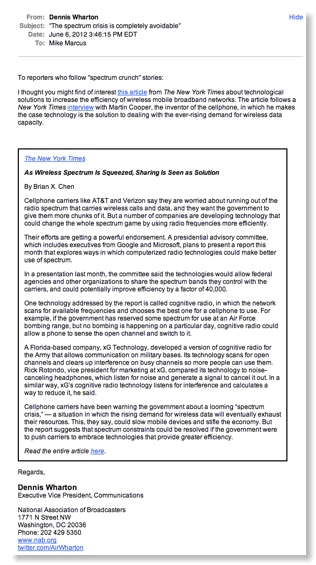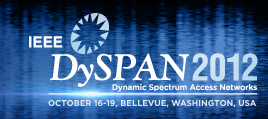NAB: Cognitive Radio is Effective Enough to Allow Sharing of Critical Government Frequencies - But Not Good Enough to Protect Broadcast TV
The National Association of Broadcasters, along with the Association for Maximum Service Television , Inc. (MSTV) (with which it has now merged), vigorously fought in 186 different filings the cognitive radio proposals in Docket 04-186 to allow secondary use of TV whitespace. When all was said and done they only allowed cognitive radio sensing with a maximum transmitter power of 50 mW (47 CFR 15.717(b)) and even that provision has an unprecedented notice and comment provision that makes its implementation unlikely.
So you can see how surprised and excited I was to get the e-mail shown at left from Dennis Wharton, Executive Vice President of Communications at NAB, with the subject line “The spectrum crisis is completely avoidable”. We certainly want to avoid this crisis and I was delighted to read what NAB’s new solution was. The message begins with “I thought you might find of interest this article from The New York Times about technological solutions to increase the efficiency of wireless mobile broadband networks.” The Times article was mainly about the PCAST spectrum report that SpectrumTalk readers read about here on May 28th. In the article Mr. Wharton was kind enough to recommend was a discussion of how effective cognitive radio technology now is and the statement “For example, if the government has reserved some spectrum for use at an Air Force bombing range, but no bombing is happening on a particular day, cognitive radio could allow a phone to sense the open channel and switch to it.”
Mr. Wharton, let me explain why it is much easier for a cognitive radio to sense in TV white space whether there are usable TV signals than the case of sensing the presence of military signals:
Based on the above, cognitive radios in the TV band raise far fewer issues than cognitive radios that try to detect the presence of military signals.
Since Mr. Wharton has concluded that cognitive radio technology has now advanced to the point that it can reliably detect the presence of military signals to allow broadband use of military bands when and where they are not in use, I assume that NAB must now endorse the technically simpler case of using of cognitive radios in the TV bands under similar terms.
I hope Mr. Wharton comes to the DySPAN 2012 Conference in Bellevue WA in October and explains NAB’s new view on cognitive radio. I’m sure he’ll get a standing ovation!
So you can see how surprised and excited I was to get the e-mail shown at left from Dennis Wharton, Executive Vice President of Communications at NAB, with the subject line “The spectrum crisis is completely avoidable”. We certainly want to avoid this crisis and I was delighted to read what NAB’s new solution was. The message begins with “I thought you might find of interest this article from The New York Times about technological solutions to increase the efficiency of wireless mobile broadband networks.” The Times article was mainly about the PCAST spectrum report that SpectrumTalk readers read about here on May 28th. In the article Mr. Wharton was kind enough to recommend was a discussion of how effective cognitive radio technology now is and the statement “For example, if the government has reserved some spectrum for use at an Air Force bombing range, but no bombing is happening on a particular day, cognitive radio could allow a phone to sense the open channel and switch to it.”
Mr. Wharton, let me explain why it is much easier for a cognitive radio to sense in TV white space whether there are usable TV signals than the case of sensing the presence of military signals:
- TV signals are generally on 24/7, they do not turn on and off at random times as military signals do.
- TV transmitters are firmly bolted to the ground in well defined locations.
- TV signals have a very precisely defined (in a public documentation) 6 MHz wide waveform with very precise frequency stability and timing. It is almost as if they were designed to be detected at much greater sensitivity than a consumer receiver. Indeed, FCC testing showed that they could be detected at a power level 35 dB less than the sensitivity of a TV receiver and better detectors are possible. In general military signals do not have waveforms that are known to the public. Thus the U-NII cognitive radio rules in 47 CFR 15.407(h)(2) require a “Radar Detection Function of Dynamic Frequency Selection” that knows nothing about the radar signal it is trying to detect since the military would no divulge the specific technical details of the radars in the band - a far cry from the well known ATSC signal in the TV band!
- If interference is caused to TV reception, it may be unfortunate but there are no permanent negative consequences - like death or injury. If there is interference to a military system the consequences could me more severe.
Based on the above, cognitive radios in the TV band raise far fewer issues than cognitive radios that try to detect the presence of military signals.
Since Mr. Wharton has concluded that cognitive radio technology has now advanced to the point that it can reliably detect the presence of military signals to allow broadband use of military bands when and where they are not in use, I assume that NAB must now endorse the technically simpler case of using of cognitive radios in the TV bands under similar terms.
I hope Mr. Wharton comes to the DySPAN 2012 Conference in Bellevue WA in October and explains NAB’s new view on cognitive radio. I’m sure he’ll get a standing ovation!
blog comments powered by Disqus





![Validate my RSS feed [Valid RSS]](valid-rss-rogers.png)

